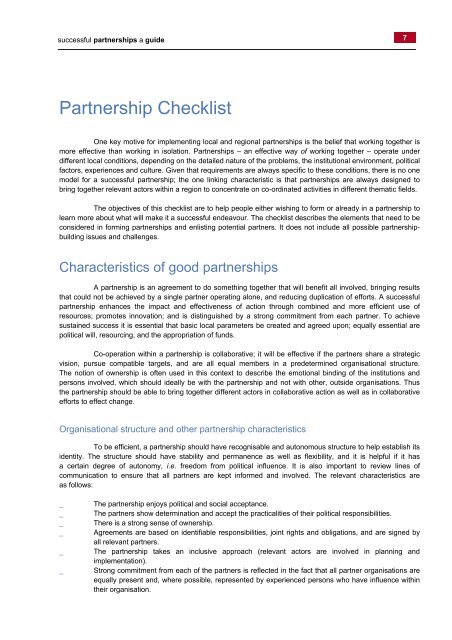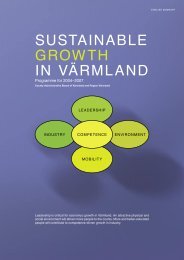successful partnerships a guide - Organisation for Economic Co ...
successful partnerships a guide - Organisation for Economic Co ...
successful partnerships a guide - Organisation for Economic Co ...
You also want an ePaper? Increase the reach of your titles
YUMPU automatically turns print PDFs into web optimized ePapers that Google loves.
<strong>successful</strong> <strong>partnerships</strong> a <strong>guide</strong><br />
7<br />
Partnership Checklist<br />
One key motive <strong>for</strong> implementing local and regional <strong>partnerships</strong> is the belief that working together is<br />
more effective than working in isolation. Partnerships – an effective way of working together – operate under<br />
different local conditions, depending on the detailed nature of the problems, the institutional environment, political<br />
factors, experiences and culture. Given that requirements are always specific to these conditions, there is no one<br />
model <strong>for</strong> a <strong>successful</strong> partnership; the one linking characteristic is that <strong>partnerships</strong> are always designed to<br />
bring together relevant actors within a region to concentrate on co-ordinated activities in different thematic fields.<br />
The objectives of this checklist are to help people either wishing to <strong>for</strong>m or already in a partnership to<br />
learn more about what will make it a <strong>successful</strong> endeavour. The checklist describes the elements that need to be<br />
considered in <strong>for</strong>ming <strong>partnerships</strong> and enlisting potential partners. It does not include all possible partnershipbuilding<br />
issues and challenges.<br />
Characteristics of good <strong>partnerships</strong><br />
A partnership is an agreement to do something together that will benefit all involved, bringing results<br />
that could not be achieved by a single partner operating alone, and reducing duplication of ef<strong>for</strong>ts. A <strong>successful</strong><br />
partnership enhances the impact and effectiveness of action through combined and more efficient use of<br />
resources; promotes innovation; and is distinguished by a strong commitment from each partner. To achieve<br />
sustained success it is essential that basic local parameters be created and agreed upon; equally essential are<br />
political will, resourcing, and the appropriation of funds.<br />
<strong>Co</strong>-operation within a partnership is collaborative; it will be effective if the partners share a strategic<br />
vision, pursue compatible targets, and are all equal members in a predetermined organisational structure.<br />
The notion of ownership is often used in this context to describe the emotional binding of the institutions and<br />
persons involved, which should ideally be with the partnership and not with other, outside organisations. Thus<br />
the partnership should be able to bring together different actors in collaborative action as well as in collaborative<br />
ef<strong>for</strong>ts to effect change.<br />
<strong>Organisation</strong>al structure and other partnership characteristics<br />
To be efficient, a partnership should have recognisable and autonomous structure to help establish its<br />
identity. The structure should have stability and permanence as well as flexibility, and it is helpful if it has<br />
a certain degree of autonomy, i.e. freedom from political influence. It is also important to review lines of<br />
communication to ensure that all partners are kept in<strong>for</strong>med and involved. The relevant characteristics are<br />
as follows:<br />
_<br />
_<br />
_<br />
_<br />
_<br />
_<br />
The partnership enjoys political and social acceptance.<br />
The partners show determination and accept the practicalities of their political responsibilities.<br />
There is a strong sense of ownership.<br />
Agreements are based on identifiable responsibilities, joint rights and obligations, and are signed by<br />
all relevant partners.<br />
The partnership takes an inclusive approach (relevant actors are involved in planning and<br />
implementation).<br />
Strong commitment from each of the partners is reflected in the fact that all partner organisations are<br />
equally present and, where possible, represented by experienced persons who have influence within<br />
their organisation.








